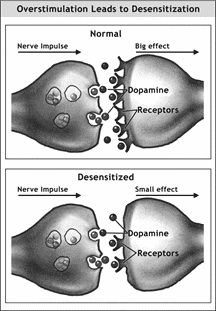Sexual Conditioning
 Adolescence is the period in our development when our brains are ready to become sexually conditioned (or programmed) in preparation for adulthood. That conditioning can happen through connection with real life mates and/or through interacting with internet pornography. This learning will literally build strong super-fast neural pathways. It will reshape our brain and our attitude to sex and love in the future. All of this is based on what we learn during this crucial period of development. It can be hard to shake off a deeply ingrained habit formed during this time at a later stage.
Adolescence is the period in our development when our brains are ready to become sexually conditioned (or programmed) in preparation for adulthood. That conditioning can happen through connection with real life mates and/or through interacting with internet pornography. This learning will literally build strong super-fast neural pathways. It will reshape our brain and our attitude to sex and love in the future. All of this is based on what we learn during this crucial period of development. It can be hard to shake off a deeply ingrained habit formed during this time at a later stage.
Until the internet became available, adolescents would sneak a look at porn in magazines or on DVDs, driven by a brain suddenly fascinated with sex. They’d “sneak” a look because such material was for adults only. Usually it was hidden out of site by fathers, older brothers or shop keepers. They’d more readily use their imagination to think about celebrities or girls in their class to release the sexual tension. As they started interacting more with other young men and women, they would venture along the often emotionally challenging route to exploring each other’s bodies leading up to sexual intimacy at some point.
Today most youngsters ‘start’ their sexual enquiries with hard-core porn to fuel their fantasies. They don’t begin with soft-core images of scantily-clad women in come-hither poses. Over 80% of porn material contains heterosexual violence against women. Painful, shocking material is also sexually arousing especially to the adolescent brain because it has a higher threshold for such excitation than the child or adult brain. People can see more extreme material in one session on their smartphones than their grandfathers could see in a lifetime. The effect of this streaming hard-core pornography reshapes the brain and its function.
Brains are not adapted to porn
 Our brains have not adapted to deal with this tsunami of hyperstimulating material that has become available in the last decade due to the arrival of broadband internet. The main health effects reported by young people and healthcare professionals are: depression; social anxiety; social isolation; brain fog; compulsive viewing of internet pornography despite negative consequences and erectile disorders.
Our brains have not adapted to deal with this tsunami of hyperstimulating material that has become available in the last decade due to the arrival of broadband internet. The main health effects reported by young people and healthcare professionals are: depression; social anxiety; social isolation; brain fog; compulsive viewing of internet pornography despite negative consequences and erectile disorders.
What’s a brain to do when it has unlimited access to a super-stimulating reward it never evolved to handle? Some brains adapt – and not in a good way. The process is gradual. At first, using porn and masturbating to orgasm resolves sexual tension and registers as satisfying.
But if we keep overstimulating ourselves, our brains may start to work against us. It protects itself against excessive dopamine by decreasing its responsiveness to it, and we feel less and less gratified. This decreased sensitivity to dopamine pushes some users into an even more determined search for stimulation, which, in turn, drives lasting changes, actual physical alterations of the brain. They can be challenging to reverse.
Why should that be so? What is different from porn of the past?
Photo by Alexander Krivitskiy on Unsplash

